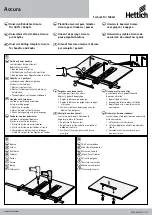
Installation manual.
CNC 8060
CNC 8065
INTRODUCTION TO
THE PLC.
3.
P
L
C r
e
sources.
·323·
(R
EF
: 1709)
3.4
PLC resources.
The PLC has the following resources.
• Inputs (I1-I1024) and outputs (O1-O1024).
• Local inputs (LI1-LI16) and local outputs (LO1-LO8).
• Marks (M1-M8192).
• Messages (MSG1-MSG1024).
• Errors (ERR1-ERR1024)
• Clocks (CLK).
• Registers (R1-R1024).
• Timers (T1-T512).
• Counters (C1-C256).
• Registers and marks for CNC-PLC communication.
The MSG, ERR, CLK and T resources are initialized (=0) when starting up the PLC. M, C
and R resources maintain their value between CNC start-ups.
Inputs (I1-I1024) and outputs (O1-O1024).
The inputs are elements that provide information to the PLC on the signals they receive from
the outside world. They are represented by the letter "I" followed by an input number between
"I1" and "I1024".
The outputs are elements that let the PLC activate or deactivate the various devices of the
electrical cabinet. They are represented by the letter "O" followed by an output number
between "O1" and "O1024".
Numbering of the physical inputs and outputs.
There are two different ways to number the inputs and outputs. Depending on the order of
the remote modules or via machine parameters. See
"3.4.1 Numbering of the physical
Local inputs (LI1-LI16) and local outputs (LO1-LO8).
The central unit has a set of 8 local digital inputs and 8 local digital signals that may be
configured both as input and output. They are called local inputs and outputs because they
are located in the central unit, not in the remote modules. The local inputs are represented
with the letter LI followed by the input number, from LI1 to LI16. The local outputs are
represented with the letter LO followed by the output number, from LO1 to LO8.
Local digital I/O are ignored when setting the number of remote I/O or when saving the
configuration of the CAN bus. Local I/O will always be referred to in the same way regardless
of the system configuration.
Local I/O will be refreshed with the same frequency as the remote I/O and also from the PE
module.
Marks (M1-M8192).
They are elements capable of memorizing in a bit (like an internal relay) the value set by the
user. If the mark is (=0), it will be referred to as being set low. If the mark is (=1), it will be
referred to as being set high.
They are represented by the letter "M" followed by a mark number between M1 and M8192.
Summary of Contents for CNC 8060
Page 1: ...Ref 1709 8060 8065 CNC Installation manual...
Page 10: ...BLANK PAGE 10...
Page 14: ...BLANK PAGE 14...
Page 20: ...BLANK PAGE 20...
Page 32: ...BLANK PAGE 32...
Page 36: ...BLANK PAGE 36...
Page 38: ...BLANK PAGE 38...
Page 40: ...BLANK PAGE 40...
Page 41: ...PART 1 INSTALLATION MANUAL...
Page 42: ...BLANK PAGE 42...
Page 532: ...Installation manual CNC 8060 CNC 8065 9 CNC VARIABLES 532 REF 1709...
Page 533: ...PART 2 CONCEPTS...
Page 534: ...BLANK PAGE 534...
Page 548: ...Installation manual CNC 8060 CNC 8065 10 GENERAL SETUP Configuration examples 548 REF 1709...
Page 644: ...Installation manual CNC 8060 CNC 8065 14 SUBROUTINES Assistance for subroutines 644 REF 1709...
Page 668: ...Installation manual CNC 8060 CNC 8065 15 HARDWARE Configure the PT100 inputs 668 REF 1709...
Page 697: ...Installation manual CNC 8060 CNC 8065 697 User notes REF 1709...
















































